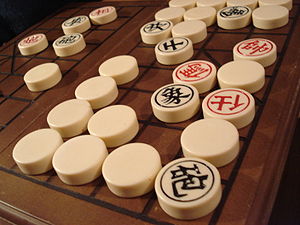
- Tabletop games
- Board games
- Tile-based games
- Turn-based games.html
- Abstract strategy games
- card games
- Connection games
- Mancala games
- Paper-and-pencil games
- Word games



 |
|
| Players | 2 |
|---|---|
| Age range | Any |
| Playing time | 5-15 minutes |
| Random chance | High |
| Skill(s) required | Tactics, Strategy |
Banqi (Chinese: 半棋; pinyin: bànqí) or Half Chess, also known as Dark Chess (暗棋) or Blind Chess (盲棋), is a two-player Chinese board game played on a 4x8 grid, or half of the xiangqi (Chinese Chess) board. Most games last between ten and twenty minutes, but advanced games can go on for an hour or more. Banqi is a social game, usually played for fun rather than serious competition. A more formal version of the game may have evolved into Jungle (board game) and modern Luzhanqi.
 Basic 4x8 Banqi board
Basic 4x8 Banqi boardAlthough boards made specifically for Banqi exist, it is common to play on one half of the xiangqi board (using only one side of the River).
Banqi uses xiangqi pieces. The backs of the pieces must be indistinguishable from each other so the pieces cannot be identified when face down. Pieces with international symbols printed on their backs are unsuitable. Each player controls five Soldiers, one General, and two each of the five other piece types, for a total of 16 pieces. In a typical set, one player’s pieces are red, and the other player’s pieces are black. The characters may also differ. For more detailed descriptions of the pieces used in this game, see the xiangqi article.
| Name of piece | Number per side | Notes |
| General, marshal, "king" 帥 shuai, 將 jiàng |
 x 1 x 1 |
Highest rank. Captures everything except soldiers. |
| Advisor, guard, minister*, assistant, mandarin, warrior 仕 shi, 士 shì |
 x 2 x 2 |
Second-highest rank in Taiwanese version. |
| Elephant, war elephant, minister* 相 xiàng, 象 xiàng |
 x 2 x 2 |
|
| Chariot, rook, cart 俥 jū, 車 jū |
 x 2 x 2 |
Second-highest rank in Hong Kong version. |
| Horse, cavalry 傌 mà, 馬 mǎ |
 x 2 x 2 |
|
| Soldier, private, pawn 兵 bīng, 卒 zú |
 x 5 x 5 |
Lowest rank, except able to capture the general. |
| Cannon, catapult 炮 pào, 砲 pào |
 x 2 x 2 |
Abilities differ in Taiwanese variations. |
The 32 pieces are shuffled and randomly allocated face-down to squares on the board. The pieces, as in Western Chess, are placed inside the squares, rather than on the intersections as in Chinese Chess.
The first player turns up a piece to begin the game. The color of that first uncovered piece is the color he or she will play in the game. The second player then makes a move, and the two alternate until the game is finished.
The game ends when a player cannot move, and that player is the loser. Most often, the game is lost because all of a player’s pieces have been captured and so he has no pieces to move. However, it is possible for one player to surround all of the other player’s remaining pieces in a manner that makes it impossible for them to move.
There are three kinds of moves. A player may turn a piece face-up, move a piece, or capture an enemy piece. In some game variants, multiple captures may be made in one turn.
Turning a piece face-up is a legal move if there are any face-down pieces on the board. Once revealed, a piece may move, capture, or be captured. In some variants of Banqi, face-down pieces may also be captured.
A player may only move face-up pieces of their own color.
Unlike xiangqi, all pieces move identically: a piece may move only one square up, down, left, or right. A piece may never move onto a square that is already occupied unless such a move is a legal capture.
Note that all pieces capture the same way that they move, except the cannon in Taiwanese rules.
A player may only capture with a face-up piece of their own color, and may only capture a face-up piece of the opposing color. In all captures, the captured piece is removed from the board and its square is occupied by the capturing piece.
The pieces are ranked, forming a hierarchy with the general at the top and soldiers at the bottom. Only pieces of equal or lower rank may be captured, with one exception. For instance, a chariot may capture a horse, and the general may capture either, but a horse cannot capture a chariot, and neither can capture the general. The one exception concerns generals and soldiers: the general cannot capture soldiers, and soldiers can capture the general. This reversal is reminiscent of Stratego.
In the Hong Kong version, the pieces are ranked in this order: general, chariot, horse, cannon, advisor,elephant, soldier. This ranking reflects the approximate value of the corresponding pieces in xiangqi (though the relative rank of horse and cannon is arguable). All pieces capture exactly as they move: one square up, down, left, or right.
In the Taiwanese version, the ranking goes as follows: general, advisor, elephant, chariot, horse, soldier. This ranking is based on the initial board positions of the corresponding pieces in xiangqi, though the horse and chariot are inexplicably swapped. Except for the cannon, pieces capture with the same motion as for movement: one square up, down, left, or right. The cannon is not included in the ranking because it is exceptional: it captures in an unusual way, it can capture a piece of any rank, and yet is vulnerable to capture by any piece except the soldier. A cannon captures as in xiangqi: it moves any distance along a single row or column of the board, jumping over exactly one intermediate piece (called a screen). Any other squares between the cannon and its target must be empty. The color of the screening piece does not matter; it may be friend or foe, or even face down. While a cannon may capture any piece, it must jump a screen to do so. Since a cannon must jump to capture, it cannot capture a piece in an adjacent square.
The Mainland Chinese version is similar to the Taiwanese version, except that cannons cannot jump. The rank of a cannon is just above that of a soldier, so the ranking is: General (black: Marshal), Scholar, Elephant (black: Minister), Chariot, Horse, Cannon (black: Catapult), Soldier (black: Pawn). Another difference is that a General/Marshal may capture a Soldier/Pawn if the General/Marshal moves first.
There are many other variations on the cannon capture rule that may add variety if desired:
A stalemate threat occurs when one player forces an endless cycle of moves. In a typical stalemate, the instigator repeatedly attacks, but cannot capture, an enemy piece. The legality of stalemating varies by culture:
Games in which stalemate is allowed tend to produce much more even games - many a lopsided game is turned into an interesting match by the surrender of a piece to avoid a stalemate.
Banqi can be played on an 8x8 board using 2 sets of Chinese chess pieces.